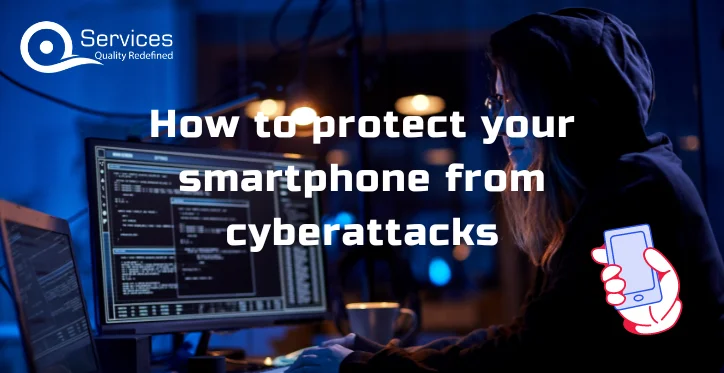Home » How to protect your smartphone from cyberattacks?

More than 60% of people depend on their smartphones for shopping, news gathering, and, other daily activities. Our cell phones have become a very important part of our life. So how will you safeguard your phone from fraudsters?
Your whole world falls apart. Right? You will feel like someone has robbed your house.
So, what will you do to avoid that?
How will you protect your phone from cyber crimes?
How will you safeguard your personal information?
Before we can give you tips on how to safeguard your phone, you need to understand the threats first.
A mobile security threat is a cyber attack that targets mobile devices like smartphones and tablets. A mobile security threat uses faults in mobile software, hardware, and network connections, much as an attack on a computer or business server, to enable malicious and unauthorized activity on the target device.
The usage of our mobile processing chips to mine bitcoins or incorporate them into botnets is one instance when hackers obtain access. The theft of personal accounts and access to identities, which they can do for as little as pennies or as much as thousands of dollars, would be a significant issue. In addition, hackers may use our financial data and mobile wallets for their own gain.
There are various ways to target mobile devices. This covers potential malicious software, network-level intrusions, and the use of mobile OS and device vulnerabilities.
Theft of corporate network login credentials is one hazard to mobile security. In fact, the number of mobile phishing assaults has increased by 85% in the past year. These attacks use texts and emails to deceive victims into clicking on harmful URLs.
Mobile devices are now more of a priority for cybercriminals due to their rising prominence. Cyber attacks directed against these devices have expanded as a result.
Your cell phones can get hacked in different forms. This covers malicious apps, network-level attacks, and the exploitation of flaws in the hardware and mobile operating system. Because mobile devices have become such an essential part of our daily lives, cybercriminals have become more active and are looking for possibilities to steal them.
Programmers who specialize in blockchain development produce applications for the technology. Before becoming a developer, they frequently had extensive expertise working with C++, Python, and Javascript. These people need to pay close attention to every detail because they hold a high-ranking position in the fiercely competitive employment market.
Mobile Ransomware is a type of mobile malware. Due to the increased usage of mobile devices for business, Ransomware has become a very common and damaging malware variant. When it is released into any phone, it encrypts the file. When you want a decryption key to regain access, a ransom demand is made.
One of the most common attack methods is phishing. Sending a phishing email with a dangerous link or malware-containing attachment is how most cyberattacks start. Phishing attacks on mobile devices can take place through a variety of channels, including email, SMS, social media platforms, and other applications.
One of the most common attack methods is phishing. Sending a phishing email with a dangerous link or malware-containing attachment is how most cyberattacks start. Phishing attacks on mobile devices can take place through a variety of channels, including email, SMS, social media platforms, and other applications.
MitM also known as a Man-in-the-Middle attack involves an attacker intercepting network communications to either keep a close eye on or modify the data being transmitted. Despite the fact that these assaults are possible on a variety of platforms, mobile devices are particularly prone to MitM attacks. SMS messages can be easily captured, and mobile applications may use unencrypted HTTP for the transfer of highly sensitive information, in comparison to web traffic.
MitM attacks looks out for person who will use unsecured wifi or mobile data. However, majority of the companies lack policies which will stop them from using these networks. So making this sort of attack is very easy.
Jailbreaking and rooting are terms for getting admin access to iOS and Android mobile devices. To gain root access on these devices, these attacks will take use of flaws in the mobile OSs. Compared to the restricted permissions available by default, these more expansive permissions allow an attacker to access more information and do more harm. This approach is made much simpler by the fact that many mobile users jailbreak or root their own smartphones to remove annoying default programmes or to install the software from shady app shops.
The focus of cybersecurity is usually on top-layer software, although lower tiers of the software layer might also have weaknesses and be hacked. Similar to computers, mobile devices have loopholes in their operating systems that can be exploited by hackers. These flaws frequently cause more harm than higher-level ones because they operate below and are invisible to the device’s security measures.
Employers who give their staff mobile devices or permit them to use their personal devices for work purposes must first set up strict security protocols and adopt mobile security best practices. Simply put, the risks are too great for CISOs and IT departments to give mobile security a low priority. Our recommendations are based on our expertise in working with businesses to improve their mobile security.
Ideal mobile security rules will cover things like required security settings, anti-theft safeguards, and permissible usage. The policy structure in an organization must also cover monitoring compliance and correcting errors.
Classifying mobile users into role-based groups with varying levels of access privileges is a good practice. This approach reduces the visible attack area if just one device is hacked. Application segmentation will also stop users from downloading potentially malicious software that could infect your network.
Reduce visibility into devices that can access the corporate network by encrypting them. If a device is compromised or stolen, it is better if a hacker cannot immediately access the data on it. Furthermore, gaining control of a mobile device shouldn’t grant access to the corporate network and its data.
This is a straightforward yet crucial defense. Security teams may help to keep those devices secure by using solutions like mobile threat detection and device and data protection tools.
Mobile users usually are not aware that their data has been hacked or that they put their data at risk. Monitoring user activity, though, can spot irregularities that would indicate an attack in progress. Automated monitoring will also be essential for ensuring that attackers do not violate the mobile security guidelines of your company.
People are used to having consumer-style freedoms on mobile devices. A smart strategy is to raise awareness of the threats that mobile technologies bring to corporate security. Keeping mobile devices safe, knowing which activities belong on enterprise devices (and which ones don’t), and using best practises every day to protect against common attacks should all be covered in security training programmes. Employee training can help your business save a lot of money and drastically decrease the threats to mobile security.
Now you know the threats, but how are you going to protect your data.
Let’s have a look:
The text message that you got from the bank could have been a scam. If any company asks you for account information via email or text, get in touch with them right away to confirm. The same warning applies to clicking links in spam emails or SMS.
This setup is simple. Visit your Location & Security Settings to see instructions for the majority of AndroidTM devices. These features are available in the General settings for iOS users.
Use sites like Google PlayTM if you’re looking for a new game or anything more useful. Make careful you read the app’s privacy statement and any accessible ratings and reviews to learn exactly what phone features the app will have access to once you download it.
In the event of an emergency, this is mainly about safeguarding and recovering your information. You can backup your contacts, music, photos, videos, and documents to the cloud with Backup Assistant Plus and Verizon Cloud.
Software and applications, both get updated on regular basis. They even help in improving security.
Once you are done making payment for any online purchase, log out of the website immediately. Other advice includes avoiding transactions when using public Wi-Fi and not saving your usernames and passwords on your phone.
Although you might not think of them as connections, thieves can use them to connect to your device and access contents.
Losing your smartphone can be quite upsetting. Every day nearly 2,00,000 gadgets get stolen, lost, or broken. Buying any gadget is not cheap.
Think about using Total Mobile Protection to avoid this. You will get a replacement if your device is lost, stolen, damaged, or has any external damage after the manufacturer’s warranty ends.
Verizon Support & Protection, a McAfee®-powered program that is a component of Total Mobile Protection, aids in defending your device against viruses, malware, and other online dangers.
If you want to give an extra layer of security to your internet connection, then use VPN. Because we rely on our mobile to stay connected with the outside world, we must be careful about our security.
You now understand that it is safe to use VPNs with mobile devices.
Your data is at risk if you choose an unsafe platform. So if you want to be safe, you should choose a trustworthy VPN provider.
Do not save all passwords; only purchase cellphones from manufacturers who release Android patches
Put two-factor authentication to use.
Use the security tools that Android has built-in.
Ensure the security of your WiFi network (and be careful with public WiFi)
Use the security app for Android.
Back up the info on your Android device.
Only purchase apps from Google Play
Secure your device
Apply a VPN
Maintain the most recent version of the iOS on your iPhone.
Turn on the “locate my iPhone” function.
Create a passcode that is longer than the default 4-number length.
Make two-factor authentication available.
Make the phone “self-destruct,” or wipe itself, after ten unsuccessful password tries.
Change your iTunes and iCloud passwords on a regular basis.
Use only secure Wi-Fi and stay away from public WiFi.
Use only reliable iPhone chargers.
On the iPhone lock screen, turn off Siri.
Removing an app’s ability to use the microphone, camera, etc.
It’s time to take phone security and mobile security risks more seriously as hackers continue to target mobile devices. Security for mobile device and PCs are no different. Safety is the same for everyone. Malware, social engineering, cyber-attacks, network attacks, and physical theft are some of the threats they are subject to.
You can relax when you know you have taken the right steps toward keeping your data and device safe. This will save you from hackers and other fraudsters who can ruin your life.
Be a man with a plan. Whether you are in charge of a company’s security or you simply wish to protect your own technology, always have a plan. Start by giving awareness training and security policy before introducing more advanced technical risk-reduction techniques.

INDIA : F-190, Phase 8B, Industrial Area, Sector 74,
Mohali, India
CANADA : 55 Village Center Place, Suite 307 Bldg 4287, Mississauga ON L4Z 1V9, Canada
USA :2598 E Sunrise Blvd, Fort Lauderdale,FL 33304,
United States

Founder and CEO

Chief Sales Officer
